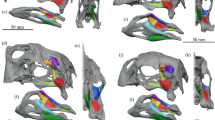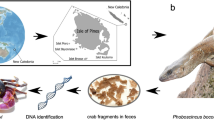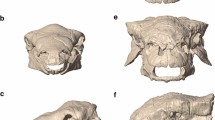Abstract
WHETHER tyrannosaurs occupied predatory or scavenging niches has been debated for nearly a century1–5. Palaeontologists have turned to the study of dental morphology to address this question, but the results have been highly disparate. Some contend that the tyrannosaur dentition was very strong and well suited for engaging and killing herbivorous dinosaurs6,7. Others posit that tyrannosaurs ate carrion, because their teeth and/or jaws would fail during struggles with prey2,3. The discovery of skeletal remains with bite marks from Tyrannosaurus rex8makes it possible to estimate, through indentation simulations on bovine ilia, the bite forces produced by T. rexduring feeding. The estimates (6,410 to 13,400 N) rival the largest bite forces determined for any taxon to date and suggest that T. rex had very strong, impact-resistant teeth. Although these data do not prove that T. rex was predominantly predacious, they indicate that its dentition could probably withstand the stresses associated with prey capture.
This is a preview of subscription content, access via your institution
Access options
Subscribe to this journal
Receive 51 print issues and online access
$199.00 per year
only $3.90 per issue
Buy this article
- Purchase on Springer Link
- Instant access to full article PDF
Prices may be subject to local taxes which are calculated during checkout
Similar content being viewed by others
References
Lambe, L. M. Mem. geol. Surv. Can. 100, 1–84 (1917).
Halstead, L. B. & Halstead, J. Dinosaurs (Blandford, Poole, UK, 1981).
Barsbold, R. Sov. Sov.-Mong. Paleontol. Eksped. Trudy 19, 1–120 (1983).
Molnar, R. E. & Farlow, J. O. in The Dinosauria (eds Weishampel, D., Dodson, P. & Osmolska, H.) 210–224 (Univ. California Press, Berkeley, 1990).
Horner, J. R. & Lessem, D. The Complete T. rex (Simon and Schuster, New York, 1993).
Farlow, J. O., Brinkman, D. L., Abler, D. L. & Currie, P. J. Mod. Geol. 16, 161–198 (1991).
Abler, W. L. Paleobiology 18, 161–183 (1992).
Erickson, G. M. & Olson, K. H. J. Vert. Paleont. 16, 175–178 (1996).
Ström, D. & Holm, S. Archs Oral Biol. 37, 997–1006 (1992).
Van Eijden, T. M. G. J. Archs Oral Biol. 36, 535–539 (1991).
Thomason, J. J. Can. J. Zool. 69, 2326–2333 (1991).
Snodgrass, J. M. & Gilbert, P. W. in Sharks, Skates, and Rays (eds Gilbert, P. W., Mathewson, R. F. & Rall, D. P.) 331–337 (Johns Hopkins Univ. Press, Baltimore, 1967).
Lucas, P. W., Peters, C. R. & Arrandale, S. R. Am. J. phys. Anthrop. 94, 365–378 (1994).
Paul, G. Predatory Dinosaurs of the World (Simon and Schuster, New York, 1988).
Edmund, A. G. Contrib. Life Sci. Div. R. Ont. Mus. 52, 1–190 (1960).
Grenard, S. Handbook of Alligators and Crocodilians (Krieger, Malabar, 1991).
Dauphin Y. Palaeontographica A 203, 171–184 (1988).
Erickson, G. M. J. Vert. Paleont. Abstr. 11, 27 (1991).
Simpson, G. G. Why and How: Some Problems and Methods in Historical Biology (Pergamon, Oxford, 1980).
Erickson, G. M. Copeia 1996, 739–743 (1996).
Alexander, R. M. Sci. Prog. 67, 109–130 (1981).
McGinnis, H. J. Carnegie's Dinosaurs (The Board of Trustees, Carnegie Institute, Pittsburgh, 1982).
Tanke, D. H. & Currie, P. J. J. Vert. Paleont. Abstr. 15, 55 (1995).
Jacobsen, A. R. J. Vert. Paleont. Abstr. 15, 37 (1995).
Currie, P. J. & Jacobsen, A. R. Can. J. Earth. Sci. 32, 922–925 (1995).
Francillon-Vieillot, H. et al. in Skeletal Biomineralization: Patterns, Processes and Evolutionary Trends (ed. Carter, J. G.) 471–530 (Van Nostrand Reinhold, New York, 1990).
Greaves, W. S. in Functional Morphology in Vertebrate Palaeontology (ed. Thomason, J. J.) 99–115 (Cambridge Univ. Press, 1995).
Carter, D. R. & Hayes, W. C. Science 194, 1174–1176 (1976).
Melvin, J. W., Fuller, P. M., Daniel, R. P. & Pavliscak, G. M. Soc. Auto. Engng. Publs. No. 690477 (Soc. Auto. Engng, Warrendale, 1969).
Sinclair, A. G. & Alexander, R. M. J. Zool. 213, 107–115 (1987).
Author information
Authors and Affiliations
Rights and permissions
About this article
Cite this article
Erickson, G., Kirk, S., Su, J. et al. Bite-force estimation for Tyrannosaurus rex from tooth-marked bones. Nature 382, 706–708 (1996). https://doi.org/10.1038/382706a0
Received:
Accepted:
Issue Date:
DOI: https://doi.org/10.1038/382706a0
This article is cited by
-
Chemical constituents, pharmacological activities, and uses of common ayurvedic medicinal plants: a future source of new drugs
Advances in Traditional Medicine (2023)
-
The Biomechanics Behind Extreme Osteophagy in Tyrannosaurus rex
Scientific Reports (2017)
-
Decoupled form and function in disparate herbivorous dinosaur clades
Scientific Reports (2016)
-
A new clade of Asian Late Cretaceous long-snouted tyrannosaurids
Nature Communications (2014)
-
Mega-Bites: Extreme jaw forces of living and extinct piranhas (Serrasalmidae)
Scientific Reports (2012)
Comments
By submitting a comment you agree to abide by our Terms and Community Guidelines. If you find something abusive or that does not comply with our terms or guidelines please flag it as inappropriate.



